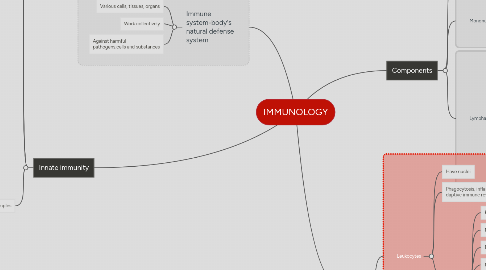
1. Immune system-body's natural defense system
1.1. Various cells, tissues, organs
1.2. Work collectively
1.3. Against harmful pathogens,cells and substances
2. Innate immunity
2.1. Non-specific
2.2. Preformed
2.3. Similar response magnitude (first and subsequent infections
2.4. No memory stored
2.5. Examples
2.5.1. First line defence
2.5.1.1. Physical barriers
2.5.1.2. Saliva, tears, skin, mucus, stomach acid, bacteria gut
2.5.2. Second line defence
2.5.2.1. Physiological barriers - hostile environment
2.5.2.2. Components
2.5.2.2.1. Fever
2.5.2.2.2. Inflammation
2.5.2.2.3. Phagocytosis
2.5.2.2.4. Antimicrobial proteins
3. Components
3.1. Cardiovascular
3.1.1. Heart, blood vesseld
3.2. Mononuclear phagocyte system
3.2.1. Reticular fibres network
3.2.2. Exp: macrohages
3.3. Lymphatic system
3.3.1. Lymphoid organs
3.3.1.1. Primary
3.3.1.1.1. Production sites
3.3.1.1.2. Maturation sites (w/o antigen)
3.3.1.1.3. Exp: bone marrow, thymus
3.3.1.2. Secondary
3.3.1.2.1. Maturation sites (with antigen)
3.3.1.2.2. Differentiate into mature antigen-specific effector cells
3.3.1.2.3. Exp: adenoid, tonsils, lymph nodes, spleen, MALT
4. Cells
4.1. Leukocytes
4.1.1. Have nuclei
4.1.2. Phagocytosis, inflammation. daptive immune response
4.1.3. Types
4.1.3.1. Basophils
4.1.3.1.1. Inflammation
4.1.3.2. Neutrophils
4.1.3.2.1. Phagocytic properties
4.1.3.3. Eosinophils
4.1.3.3.1. Parasitic infections, allergic
4.1.3.4. Monocyte
4.1.3.4.1. Precursor for macrophages
4.1.3.5. Lymphocytes
4.1.3.5.1. B-cells and T-cells
4.1.3.6. Mast cells
4.1.3.6.1. 'master regulators'
4.1.3.7. Natural killer (NK) cells
4.1.3.7.1. cytotoxic- contain special protein (granzymes)
4.1.3.7.2. Tumor and viral infection
4.2. Platelets
4.2.1. No nuclei
4.2.2. Inflammation, blood clotting
